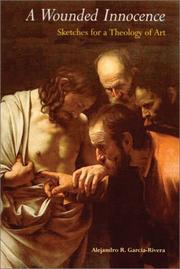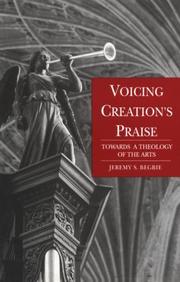| Listing 1 - 10 of 107 | << page >> |
Sort by
|
Book
Year: 1993 Publisher: S.l. : Bartholomew,
Abstract | Keywords | Export | Availability | Bookmark
 Loading...
Loading...Choose an application
- Reference Manager
- EndNote
- RefWorks (Direct export to RefWorks)
Book
ISBN: 0830857966 9780830857968 9780830851065 Year: 2019 Publisher: Downers Grove, Illinois
Abstract | Keywords | Export | Availability | Bookmark
 Loading...
Loading...Choose an application
- Reference Manager
- EndNote
- RefWorks (Direct export to RefWorks)
"In search of holistic Christian witness, we must cultivate new approaches for integrating the arts into mission praxis. Written by missiologists, art critics, ethnodoxologists, and theologians from around the world, these essays present historical and contemporary case studies while calling Christians to understand the power of art for expressing cultural and religious identity, opening spaces for transformative encounters, and resisting injustice"--
Book
ISBN: 9781602583535 9781602583511 160258351X 9781602583528 1602583528 1602583536 Year: 2022 Publisher: Waco Baylor University Press
Abstract | Keywords | Export | Availability | Bookmark
 Loading...
Loading...Choose an application
- Reference Manager
- EndNote
- RefWorks (Direct export to RefWorks)
It is often difficult to describe beauty or even justify attempts to experience something beautiful. Yet if artists—whether painters or poets, actors or musicians, architects or sculptors—teach us anything, it is that the pursuit of beauty is a common feature among all humanity. As Cecilia González-Andrieu contends, these varied experiences with artistic beauty are embedded with revelatory and prophetic power that not only affects a single individual but allows for communal formation. Named one of America magazine's most promising young theologians, González-Andrieu seeks to engage art in order to reveal its religious significance. Bridge to Wonder proposes a method of theological aesthetics allowing readers to mine the depths of creative beauty to discover variegated theological truths that enable greater communion with each other and the One source of all that is beautiful.
Book
ISBN: 9781003008965 9780367443214 9780367776084 Year: 2021 Publisher: Abingdon Routledge
Abstract | Keywords | Export | Availability | Bookmark
 Loading...
Loading...Choose an application
- Reference Manager
- EndNote
- RefWorks (Direct export to RefWorks)
"This volume explores how the visual arts are presenting and responding to Christian theology and demonstrates how modern and contemporary artists and artworks have actively engaged in conversation with Christianity. Modern intellectual enquiry has often been reluctant to engage theology as an enriching or useful form of visual analysis, but critics are increasingly revisiting religious narratives and Christian thought in pursuit of understanding our present-day visual culture. In this book an international group of contributors demonstrate how theology is often implicit within artworks and how, regardless of a viewer's personal faith, it can become implicit in a viewer's visual encounter. Their observations include deliberate juxtaposition of Christian symbols; imaginative play with theologies; the validation of non-confessional or secular public engagement; and inversions of biblical interpretation. Case-studies such as an interactive Easter, glow-sticks as sacrament, and visualisation of the Bible's polyphonic voices enrich this discussion. Together, they call for a greater interpretative generosity and more nuance around theology's cultural contexts in the modern era. By engaging with theology, culture and the visual art, this collection offers a fresh lens through which to see the interaction of religion and art. As such, it will be of great use to those working in Religion and the Arts, Visual Art, Material Religion, Theology, Aesthetics and Cultural Studies"--
Book
ISBN: 3459013494 Year: 1981 Publisher: München Kaiser
Abstract | Keywords | Export | Availability | Bookmark
 Loading...
Loading...Choose an application
- Reference Manager
- EndNote
- RefWorks (Direct export to RefWorks)
Book
ISBN: 9780801099571 0801099579 Year: 2018 Publisher: Grand Rapids, MI Baker Academic
Abstract | Keywords | Export | Availability | Bookmark
 Loading...
Loading...Choose an application
- Reference Manager
- EndNote
- RefWorks (Direct export to RefWorks)
World-renowned theologian Jeremy Begbie has been at the forefront of teaching and writing on theology and the arts for more than twenty years. Amid current debates and discussions on the topic, Begbie emphasizes the role of a biblically grounded creedal orthodoxy as he shows how Christian theology and the arts can enrich each other. Throughout the book, Begbie demonstrates the power of classic trinitarian faith to bring illumination, surprise, and delight whenever it engages with the arts.

ISBN: 0814651127 Year: 2003 Publisher: Collegeville Liturgical Press
Abstract | Keywords | Export | Availability | Bookmark
 Loading...
Loading...Choose an application
- Reference Manager
- EndNote
- RefWorks (Direct export to RefWorks)

ISBN: 056729188X Year: 1991 Publisher: Edinburgh Clark
Abstract | Keywords | Export | Availability | Bookmark
 Loading...
Loading...Choose an application
- Reference Manager
- EndNote
- RefWorks (Direct export to RefWorks)
Book
ISBN: 9780190279769 0190279761 Year: 2017 Publisher: Oxford Oxford University Press
Abstract | Keywords | Export | Availability | Bookmark
 Loading...
Loading...Choose an application
- Reference Manager
- EndNote
- RefWorks (Direct export to RefWorks)
The stories gathered in these pages lay bare the power of the arts to unsettle and rework deeply ingrained religious beliefs and practices. This book grounds its narrative in the accounts of 82 Evangelicals who underwent a sea-change of religious identity through the intervention of the arts. "There never would have been an undoing of my conservative Evangelical worldview" confides one young man, "without my encounter with the transcendent work of Mark Rothko on that rainy afternoon in London's Tate Modern." "The characters in The Brothers Karamazov began to feel like family to me," reports another individual, "and the doubts of Ivan Karamazov slowly saturated my soul." As their stories unfold, the subjects of the study describe the arts as sources of, by turns, "defamiliarization," "comfort in uncertainty," "a stand-in for faith" and a "surrogate transcendence." Drawing on memoirs, interviews, and field notes, Philip Salim Francis explores the complex interrelationship of religion and art in the modern West, and offers an important new resource for on-going debates about the role of the arts in education and social life. - Publisher.
Book
ISBN: 9781409431619 9781409431626 Year: 2011 Publisher: Farnham Ashgate
Abstract | Keywords | Export | Availability | Bookmark
 Loading...
Loading...Choose an application
- Reference Manager
- EndNote
- RefWorks (Direct export to RefWorks)
| Listing 1 - 10 of 107 | << page >> |
Sort by
|

 Search
Search Feedback
Feedback About UniCat
About UniCat  Help
Help News
News